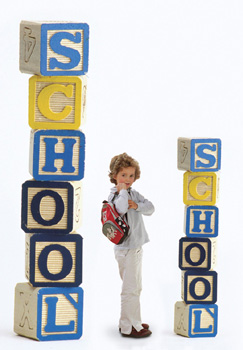 |
 |
 Dec/Jan 2005
Dec/Jan 2005
Education Guide
Small Versus Large Schools: Which is Best for Your Child?
by Virginie Kippelen
 |
Atlanta is a city known to have something for every need and when it comes to choosing a school based on size, this is equally true. Atlanta offers a large variety of schools, from small to large to very big. Counties in Atlanta that have experienced a rapid growth of population usually have consolidated small schools in larger institutions or built larger schools. This is the case in Gwinnett County, the largest school system in Georgia, with more than 110,000 students attending one of 87 schools. On the other end of the spectrum, the city of Decatur, in DeKalb County, has long favored a small school system and offers four elementary schools, one middle school and one high school for a total of 2,600 students.
What is large and what is small?
Although there is no conclusive research on the question, the average size for a public elementary school is in the range of 300-400 students and 400-800 students for a middle school. High school population is generally higher and can go up to 3,000-4,000 students in some counties.
On the other hand, private institutions can combine elementary and secondary grades. This is the case for Mount Paran Christian School a private K-12 grade school in Kennesaw, with a student population of 950. "If we compare ourselves with other Christian schools, we are a fairly large school. If we compare ourselves with public schools in general, we are small. Now, if we compare ourselves with public high schools, we are very small," says David Tilley, the school's headmaster.
More meaningful numbers
In researching the right equation for your child, parents need to evaluate other information. At the top of the list come the number of students per class, the ratio of students per teacher and the number of classes per grade.
Many reports have surfaced in the recent years showing that smaller is better wh
en it comes to educating our children. Educators, in general, favor small settings and think that small classes improve student learning. This is especially true for small grades (Pre-K and Kindergarten) where students require more space and less crowded rooms. On average, a good ratio of student per teacher for elementary grades is 15 to 20 students per teacher and goes up to 25 and higher with secondary grades.
Bigger school equals more choices?
The assumption that students attending large schools have access to a broader curriculum and a larger variety of extra-curricular activities has been recently criticized. Some reports show that small schools often allow greater student participation in extra-curricular activities and that students in large schools tend to be more polarized.
In addition, opponents of large schools cite the sense of alienation that comes with large facilities, labyrinthian hallways and row after row of lockers. The sense of intimacy that comes with small classes is precisely what drew Caroline Enloe, a mother of four, to choose Decatur's elementary schools. "There is a greater feeling of being part of the community, and it gives me the chance to be known as a person instead of a grade-level parent."
However, small schools face economic challenges. The city of Decatur's school system was recently in the news when its administrators decided to close some neighborhood elementary schools on the basis of low attendance and high operating costs. They eventually recombined all their elementary schools into three categories: one pre-K, three K-3rd grade and one 4-5th grade academy.
Small schools as well as large schools have their advantages and drawbacks. After you have done your homework and narrowed your choices down to a few schools, nothing is more critical than paying a thorough visit to each of those schools and asking many questions to assure a good fit for your child.
|
 |
|
 |